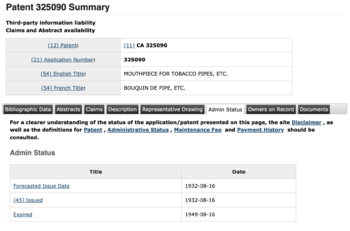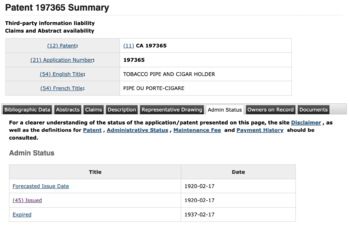Dating Guide Addendum: Difference between revisions
No edit summary |
No edit summary |
||
| Line 19: | Line 19: | ||
'''About Inner Tube w/ Flange registred in Canada.''' | '''About Inner Tube w/ Flange registred in Canada.''' | ||
Loring pointed out in his studies that this patent was used between 1927 and 1941. However, that patent was granted on February 17, 1920, and expired on February 17, 1937. He does not make clear the reason for this possible six-year period without using this patent or because it would be used after the registration had expired. | |||
A plausible possibility is that this postponement occurred because of the validity of patent 158709, another Canadian patent for Inner Tube (without flange), which expired in 1926. Although, we can observe the concurrent use of British patents 5861/12 (for Inner Tube) and 116989/17 (Inner Tube w/ Flange) between 1918 and 1926. As we can see, one thing does not exclude the other. | |||
I believe that this patent was used throughout its term and that it was also not used after the concession period - i.e, it was used between 1920 and 1937 on pipes directed to Canada. | |||
<br> | <br> | ||
<div class="separator" style="clear: both; text-align: center;"></div> | <div class="separator" style="clear: both; text-align: center;"></div> | ||
---- | ---- | ||
13:17, 6 July 2020 (CDT) | 13:17, 6 July 2020 (CDT) | ||
Revision as of 12:38, 7 July 2020
Addendum 1.
About Vernon Fitment in Canada.
I believe Loring made a minor typo by writing the patent number - instead of 356090, being 325090 as we can see in the patent record.
Loring also mentions that the patent would have been registered in 1934 or '35 and was granted in '35 or '36. In fact, this patent was granted on August 16, 1932 - a few years earlier than he expected (he also can not determine the period in which the patent was applied).
According to the official patent record, the patent expired 17 years later, i.e. on August 16, 1949. Possibly it was used during this period on pipes directed to the Canadian market.
It seems, that the fitment was not a tremendous success, and perhaps the production ceased before this period but we need time to see if more pipes with that patent will appear. Anyhow, it's a plausible possibility that the patent was used during that time. We also know now that we can find pipes with this patent sooner than we thought.
- See the patent file here.
- See the patent record on offcial Canadian Intellectual Property Office here.
Addendum 2.
About Inner Tube w/ Flange registred in Canada.
Loring pointed out in his studies that this patent was used between 1927 and 1941. However, that patent was granted on February 17, 1920, and expired on February 17, 1937. He does not make clear the reason for this possible six-year period without using this patent or because it would be used after the registration had expired. A plausible possibility is that this postponement occurred because of the validity of patent 158709, another Canadian patent for Inner Tube (without flange), which expired in 1926. Although, we can observe the concurrent use of British patents 5861/12 (for Inner Tube) and 116989/17 (Inner Tube w/ Flange) between 1918 and 1926. As we can see, one thing does not exclude the other.
I believe that this patent was used throughout its term and that it was also not used after the concession period - i.e, it was used between 1920 and 1937 on pipes directed to Canada.
13:17, 6 July 2020 (CDT)

